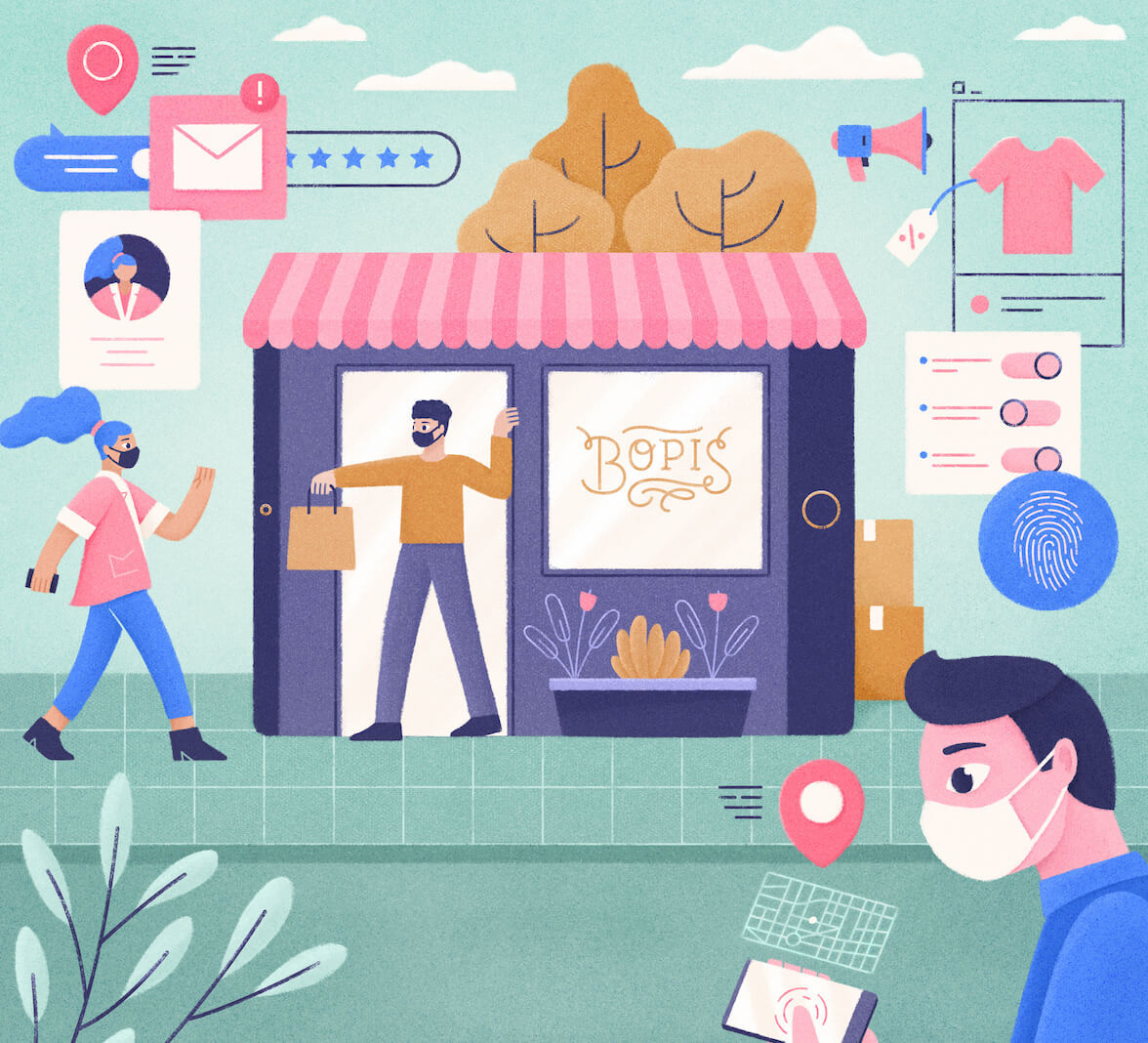You successfully responded to the pandemic by speeding your digital transformation by six, maybe even 10, years ahead of your road map. After achieving overnight agility, what’s next?
Across sectors, we’ve seen a rise in digital adoption, including in demographics that have previously been slow to reach for apps, like Boomers and seniors. Lockdowns drove the discovery of digital solutions to daily needs, resulting in an uptick in online grocery sales and an increase in curbside pickup.
A McKinsey survey of 20,000 European consumers in the spring of 2020 found that on average, 70% of consumers across sectors said they intended to continue using digital services after COVID-19 as much as they did during the pandemic. “There’s no going back,” notes McKinsey. “Bold vision and disciplined execution on a set of key imperatives will ultimately differentiate the leaders from the laggards as this crisis abates.”
In other words, a decent digital experience is now table stakes.
Fine-tuning work that might have been rushed during the pandemic and checking for security and compliance issues will be covered in a future series. Right now, let’s take a look at why your brand experience needs to be seamless, whether your consumer finds you in the digital world or the real one.

Retail: Craft New Buying Experiences
Customer loyalty got a shock during the pandemic, with 75% of surveyed US consumers saying they had tried a new shopping behavior by June of 2020, whether new brands, a different shopping method or even different retailers, reports McKinsey. For those who tried a new digital method, 80% say they intend to continue.
The good news for businesses is that COVID-19 drove an increased appetite for new experiences. Implementing a new experience doesn’t have to be complicated, but the ones that showed early success were driven by the combination of real-world experience with digital.
✔︎ How ecobee confidently entered home security
✔︎ Optical retailer Grandvision on creating an omnichannel experience
While many restaurants suffered due to lockdown requirements in 2020, brands that offered drive-through and added curbside pickup fared better. Restaurant Brand International Inc. (RBI), the owner of brands like Burger King and Tim Hortons, says digital sales grew more than 120% YOY in Q2 of 2020. RBI CEO Jose Cil expects curbside pickup will see long-term growth since it expanded access without cannibalizing drive-through traffic.
That experience was mirrored at hypermarket Walmart which added a curbside pickup to grow online sales by 79% in Q3 and another 69% in Q4.
Consumer electronics retailer Best Buy reported a 300% growth in domestic online sales during a curbside pickup experiment, with an additional 90% increase in sales driven by digital access and attention to customer experience in Q4.
Mobile matters
But, as Forbes points out, “Curbside doesn’t just happen at the flip of a switch. Most of the brands that have successfully added the channel in the past six months have a robust mobile app in place, which facilitates the ordering process.”
Best Buy has continued to experiment with customer experience, strategically opening some stores for one-to-one shopping appointments and converting 450 stores to fulfillment centers. In addition to curbside pickup, Best Buy turned to Shipt to handle “last mile” delivery and Instacart for same-day orders.
Forbes believes Best Buy is creating an entirely new retail approach that combines supply chain optimization with retail experience: “The only long-term differentiators of a physical and digital experience are the confidence one gets from the helpful human-to-human interactions inside of a store or the social experience of shopping itself.”
But not every shopping experience requires a human to be convenient.
Touchless sales along the lines of the Amazon GO model, which relies on sensors combined with the Prime app, offer another way of interacting with your consumers. Recently LG phones introduced a store that takes self-checkout one step further — there are no salespeople in the store. Consumers use simple authentication and payment to interact with screens and self-select their phones and plans. Questions about comparing models or detailed payment concerns are handled by an AI chatbot with deep language learning enabled.
Your brand’s app is the constant in all of these scenarios. While the mobile app became the primary mode of interaction during the pandemic, as the world opens up, it’s proving to be a primary enabler of physical access as well.
FinServ: Scale to Meet Digital Demand
According to FTI Consulting, 70% of financial services companies surveyed regarding COVID-19’s impact had a digital transformation plan in place or were working on one when the pandemic hit.
But that doesn’t mean financial service companies were fully ready for serious traffic spikes.
The coronavirus drove a 72% increase in financial apps and mobile banking use in a single week due to lockdowns in Europe, according to research published by financial advisory organization deVere Group.
Lockdown shutters of brick-and-mortar offices drove people to increased digital transactions in Latin America as well, where Visa shared that 13 million customers had made their first-ever online transaction by the quarter ending in March 2020. Visa Chief Product Officer Jack Forestell also told MarketWatch that he expects face-to-face transactions to get an “electronic spin” as brick-and-mortar locations reopen because the actual transaction is already happening electronically.
✔︎Credit card giant Naranja seeds digital evolution [video]
✔︎How British wealth management company Nutmeg tightened security
Responding to consumer expectations of safety, security, and convenience has required massive change. In a Deloitte report, PNC Bank’s CEO William Demchak says, “The bank’s sales have jumped to nearly 75% digital during COVID-19, condensing 10 years worth of changes into two months.”
TD Bank also made digital investments it didn’t expect to make in 2020 to allow 80% of its workforce to work from home, reports Born Digital. But the pandemic has also altered the company’s decision-making process. Noting that banks can sometimes have a reputation for slow decision-making, Michael Rhodes, Group Head of Innovation, Technology, and Shared Services at TD Bank Group, told Born Digital, “We are not being slow right now. We have cross-functional teams that go to the war room, and we empower them to make a decision.”
Insurers also had to make rapid changes in response to the pandemic. In a global survey of insurance CEOs, KPMG International found that 78% had “turbo-charged progress on the creation of a seamless digital customer experience.”
KPMG underscored the urgency to meet customer expectations:
“With lots of digital competition now in the market, customers have become increasingly willing to reconsider their insurance options. Having been forced to do all their other purchases online, customers have become increasingly comfortable with buying products (even complicated financial ones) virtually; new or more digitally savvy customers will naturally be drawn to those with the best digital offering,” writes Laura J. Hay, Global Head of Insurance, KPMG.
Healthcare: Accelerate time-to-value
Out of all of the industries, one could say that healthcare made the most dramatic changes in response to the pandemic. Nearly half of consumers replaced in-person appointments with telehealth visits, says McKinsey. Others simply postponed treatment.
For healthcare systems that rely heavily on insurer payments, this brought financial challenges. US hospitals lost billions in revenue in 2020 and could lose between $53 and $122 billion in 2021 depending on how the pandemic progresses, says a recent report from the American Health Association.
The need to protect at-risk patients and get test results out quickly massively accelerated change in an industry that’s been traditionally slower to move due to the need to protect sensitive patient data and comply with regulations. For example, BioReference labs switched from a model of delivering lab results primarily to healthcare providers to managing a 25X increase in volume as they started working directly with patients who were seeking rapid COVID-19 results.
“COVID-19 has caused a seven to ten year acceleration in consumer and digital trends,” says Richard Schwabacher, Senior VP for Digital Health and Chief Digital Officer at BioReference Labs.
✔︎How BioReference Labs handled a 25x volume spike
✔︎How Lifen implemented remote monitoring in 5 days
Digital health includes areas that may seem obvious to consumers accustomed to quantifying their lives via their Apple Watches or FitBits. In a healthcare setting, however, adoption rates for digital devices are still low. Access to devices, potential inconsistencies with patient compliance and availability, and doctors’ comfort with using the devices as points of information, to say nothing of insurers’ willingness to cover costs, are all contributing factors.
But global venture capital investment in digital health rose rapidly over the course of 2020, increasing 66% over the previous year’s investment to $14.8 billion. Telehealth alone saw a 139% increase. VCs are betting that these changes are here to stay.
“The pandemic has mainstreamed the consumer side of digital health technologies in less than a year. Digital health products that were a novelty a year or two ago are now a necessity,” says Raj Prabhu, CEO of Mercom Capital Group, in a release.
Historically, healthcare providers have handled consumer personalization by creating contained medical campuses or focused care centers for childbirth or cardiology that could offer a consistent look and feel, says Schwabacher. That experience sometimes faltered when moving from the physical experience to the digital one. The need to protect patient privacy and adhere to regulations often meant choosing security over convenience, resulting in a digital experience that wasn’t always able to seamlessly follow the patient from primary care physician to a specialist.
Noting that digital options have become more prevalent and personalized in the equally regulated financial services industry, Schwabacher sees a pattern for potential change.
Greater reliance on digital health opens up opportunities to tailor experiences more specifically to the individual. This will allow healthcare systems to provide the consumer experience patients are coming to expect — and it has the even more exciting potential to improve patient outcomes, says Schwabacher in this guest post.

Questions to Ask Your Team
Brand response to a seven- to 10-year forced leap into the future could mean that we’re poised to see even greater innovation as we come out of the pandemic, but that change doesn’t have to be overwhelming. Here are three questions to take back to your team:
- What happens if you treat your app as the gateway to physical interaction? Does this open up new ways to structure your consumers’ experiences?
- How can you conduct short experiments that provide actionable insights within a single quarter?
- Can you apply lessons learned from other industries to overcome your current challenges?
Brands’ need to thrive will push them to create new consumer experiences with the support of technology. If you’d like to explore how a strong CIAM solution can help make your experiment a reality, please reach out to the team at Auth0.
About Auth0
Auth0 by Okta takes a modern approach to customer identity and enables organizations to provide secure access to any application, for any user. Auth0 is a highly customizable platform that is as simple as development teams want, and as flexible as they need. Safeguarding billions of login transactions each month, Auth0 delivers convenience, privacy, and security so customers can focus on innovation. For more information, visit https://auth0.com.
About the author

Jenny O'Brien
Business Content Manager
